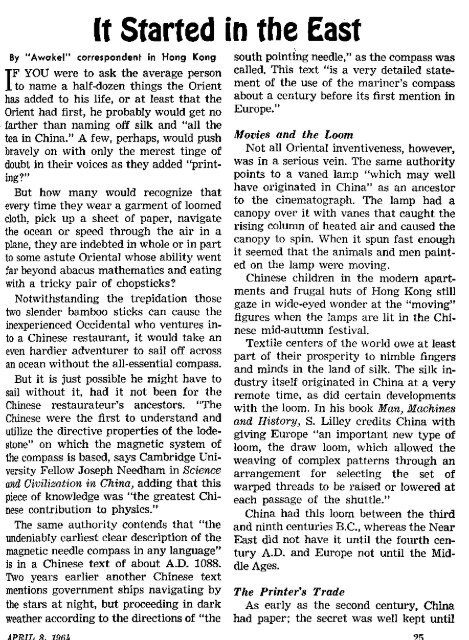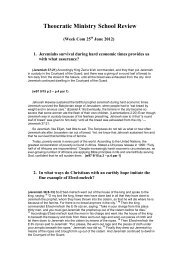1964 Awake! - Theocratic Collector.com
1964 Awake! - Theocratic Collector.com
1964 Awake! - Theocratic Collector.com
Create successful ePaper yourself
Turn your PDF publications into a flip-book with our unique Google optimized e-Paper software.
It Started in the East<br />
By "<strong>Awake</strong>l" correspondent in Hong Kong<br />
IF YOU were to ask the average person<br />
to name a half -dozen things the Orient<br />
has added to his life, or at least that the<br />
Orient had first, he probably would get no<br />
farther than naming off silk and "all the<br />
tea in China." A few, perhaps, would push<br />
bravely on with only the merest tinge of<br />
doubt in their voices as they added "printing?"<br />
But how many would recognize that<br />
every time they wear a garment of loomed<br />
cloth, pick up a sheet of paper, navigate<br />
the ocean or speed through the air in a<br />
plane, they are indebted in whole or in part<br />
to some astute Oriental whose ability went<br />
far beyond abacus mathematics and eating<br />
with a tricky pair of chopsticks?<br />
Notwithstanding the trepidation those<br />
two slender ba mboD sticks can cause the<br />
inexperienced Occidental who ventures into<br />
a Chinese restaurant, it would take an<br />
even hardier adventurer to sail off across<br />
an ocean without the all-essential <strong>com</strong>pass.<br />
But it is just possible he might have to<br />
sail without it, had it not been for the<br />
Chinese restaurateur's ancestors. "The<br />
Chinese were the first to understand and<br />
utilize the directive properties of the lodestone"<br />
on which the magnetic system of<br />
the <strong>com</strong>pass is based, says Cambridge University<br />
Fellow Joseph Needham in Science<br />
and Civilization in China, adding that this<br />
piece of knowledge was "the greatest Chinese<br />
contribution to physics."<br />
The same authority contends that "the<br />
undeniably earliest clear description of the<br />
magnetic needle <strong>com</strong>pass in any language"<br />
is in a Chinese text of about A.D. 1088.<br />
Two years earlier another Chinese text<br />
mentions government ships navigating by<br />
the stars at night, but proceeding in dark<br />
weather according to the directions of "the<br />
,<br />
south pointing needle," as the <strong>com</strong>pass was<br />
called. This text "is a very detailed statement<br />
of the use of the mariner's <strong>com</strong>pass<br />
about a century before its first mention in<br />
Europe."<br />
Movies and the Loom<br />
Not all Oriental inventiveness, however,<br />
was in a serious vein. The same authority<br />
points to a vaned lamp "which may well<br />
have originated in China" as an ancestor<br />
to the cinematograph. The lamp had a<br />
canopy over it with vanes that caught the<br />
rising column of heated air and caused the<br />
canopy to spin. When it spun fast enough<br />
it seemed that the animals and men painted<br />
on the lamp were moving.<br />
Chinese children in the modern apartments<br />
and frugal huts of Hong Kong still<br />
gaze in wide-eyed wonder at the "moving"<br />
figures when the lamps are lit in the Chinese<br />
mid-autumn festival.<br />
Textile centers of the world owe at least<br />
part of their prosperity to nimble fingers<br />
and minds in the land of silk. The silk industry<br />
itself originated in China at a very<br />
remote time, as did certain developments<br />
with the loom. In his book Man, Machines<br />
and History, S. Lilley credits China with<br />
giving Europe "an important new type of<br />
loom, the draw loom, which allowed the<br />
weaving of <strong>com</strong>plex patterns through an<br />
arrangement for selecting the set of<br />
warped threads to be raised or lowered at<br />
each passage of the shuttle."<br />
China had this loom between the third<br />
and ninth centuries B.C., whereas the Near<br />
East did not have it until the fourth century<br />
A.D. and Europe not until the Middle<br />
Ages.<br />
The Printer's Trade<br />
As early as the second century, China<br />
had paper; the secret was well kept until




